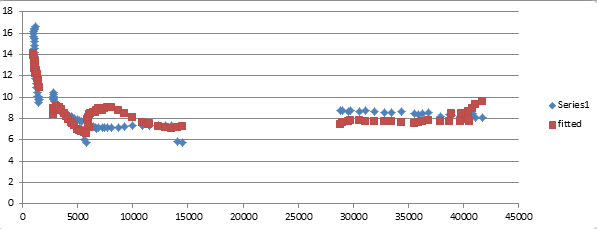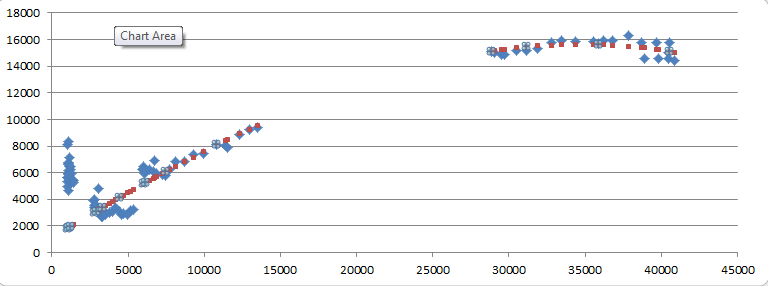Unmasking the ignorance and superstition of the modern age
An age of Twitter-fuelled ‘truthiness’
I have rarely felt so profoundly disappointed with the state of the rational world as I do these past few weeks. Perhaps it was my own cognitive dissonance at play, but if you had asked me a few short months ago, I would have rated our level of collective rationality as – overall – pretty high. Boy, was I wrong.
In fact, we live in a world in which the principles of scientific observation are disregarded, or else regarded selectively, in such a way as to concur with our collective feelings; in this case, collective hysteria. It is, as someone I know once put it, the essence of ‘policy-based evidence-making’. The clearest and most horrible example is the widespread use of the ‘number of cases’ statistic in the context of the COVID flare-up that struck in March/April (and has since gone away from almost all parts of the world). You won’t see a news report these days that doesn’t quote the ‘number of cases’, despite all honest epidimologists knowing the case count is a meaningless number: It tells you a little bit about the level of testing and nothing at all about the infection rate, for the strikingly obvious reason that the denominator is completely unknown.
See no evil, hear no evil, spit no droplets of evil
Another good example is the use of face masks. They are more than just ubiquitous, they are fashionable. While in a shop yesterday, I took the opportunity to engage the mouthless young woman behind the til in conversation. Did her employer insist she wear one? No, came the muffled response from where her mouth should have been, but she chose to, because it made her feel better. “Although I don’t really know if it does anything,” she added, almost apologetically.
That’s of course fine. In a free society, anyone should have the right to adorn their bodies with whatever tin foil armour they believe might protect them from their chosen alien invaders. The problem is when the use of such adornments becomes compulsory thoughout the ‘free’ world, as is now the case on public transport, on flights, in indoor spaces, and even on public streets.
A narrative built on a meta-study built on a not-so-randomised control trail
Let’s be perfectly clear: there is no evidence that face masks protect against the spread of viral infections in the community setting. And I say this after having spent some time reviewing, line by line, the extant literature that has been recently quoted by proponents of the practice. What is shocking is how disingenious the pro-mask campaign can be.
One good example of how bad some of these studies are is to be found in one NYC radomised control trial from 2010, in which 450 households in a predominantly Latino neighbourhood were studied, divided into three control groups: Group one was given ‘education’ only about how to reduce infection. The second group was given ‘education plus hand sanitizer’. The third group was given ‘education plus hand sanitizer plus face masks’, with instructions that the head of household should wear one if anyone displayed symptoms, as well as children over 3 and ‘if possible’ the sick elderly person in the household.

The study reports the characteristics of the three groups, which despite ‘randomisation’ show clearly that the group which received face masks had different socio-economic characteristics: 50.8% of the face mask adults had high school diplomas or better, as against only 40.2% for the ‘education only’ control group. Then, though admitting that the face mask group never really used the face masks anyway, the authors proceed to conclude that the face masks are effective in reducing transmission of influenza.
This, in turn, is one of a number of studies quoted in the metastudies, such as the May 22 2020 Annals of Internal Medicine review, which in turn is used by media sources to support the public narrative. Even if these studies are cautious not to lie (the May 22 metastudy includes the rather unambiguous statement that “No direct evidence indicates that public mask wearing protects either the wearer or others.”), the authors know it’s the headlines that grab the public attention. And theirs is unambiguous in its messaging: “Cloth Masks May Prevent Transmission of COVID-19”. Again, not a lie, but it’s also true that pulverised moondust mixed with elephant tusk may cure cancer. No evidence, mind you, but it may.
Unmasking the cover-up
A question is why, if I can discover all this in a few days’ reading as a lay person, the medical, scientific and political establishment is so keen on pushing the face mask narrative? I posit a couple of possible answers.
First, a benign suggestion: The shock which COVID hysteria caused in society is best managed by allowing for a gradual return to normal. Like the masked salesgirl I refer to above, people actually feel better, more secure, with the masks. The argument then goes that we, as a society, should all mask up – at least for a while – to help the shellshocked return to public life without undue fear.
Now a more malignant thought: What if the political forces, including state-associated virologists and medical experts, now know that they massively overreacted to the outbreak of COVID-19? Maybe they have figured out, well ahead of the public, that the lockdowns were mostly ineffective (coming weeks if not months after they could have made any difference), and the infection fatality rate may in fact be as low as 0.05%. They also realise that they have wreaked untold harm on the economies and societies whose management was entrusted to them. Reputations, maybe even careers, are at stake. The game is now one of making ‘unlocking’ seem gradual, complicated, drawn out; because if they went back to normal too quickly, questions might be raised about why exactly we were forced to give up a third of our economy and two thirds of our civil liberties.
My review of Gary Paulsen’s ‘Hatchet’
 Hatchet by Gary Paulsen
Hatchet by Gary Paulsen
My rating: 3 of 5 stars
Some books smack of polish. The prose is heavy with the weight of old creative writing classes or mimickry of past literary idols.
Sometimes the polish even drips and coagulates into globs at the bottom of the page. It’s as if we can smell the coffee from the Starbucks where the author sat, back in February of 1998, when she first read Hemingway and, looking out the window at the drab Seattle rain, dreamt of one day living in New York City and ‘being an author’. Or else we hear the writer’s impatient fingers upon the keyboard at his office in the community college’s English department, desperately trying to ‘find his voice’ the way he tells his students to, rather than just telling a story.
Gary Paulsen’s Hatchet is certainly not one of these books. The prose has no polish whatsoever. As a result, the writing is crude, almost to the point of distraction. Choppy. Fragments of sentences, running on. An attempt. An attempt to convey the protagonist’s panicked state of mind. A heavy-handed abuse of language. At least in my opinion.
But what Paulsen lacks in literary finesse, he more than makes up for with the quality of his story. The tale is a simple one – a teenage boy named Brian survives the crash of a single engine plane and must learn to live in the Canadian wilderness, with only the eponymous hatchet and the clothes on his back.
Like all great stories, Paulsen has no need to mimic other writers, or to worry about finding a voice. He simply tells Brian’s story, and that is more than enough for the reader to suspend disbelief; to join Brian in the woods, rejoicing with him over every little comfort, salivating at the taste of berries and fish in the starving boy’s mouth.
I understand completely why this book has become a favourite of high school English teachers. And as is the case with all good young adult fiction, it reads just as well, even if you are much older.
Costs and Benefits of Lockdown (2): Translating GDP into human lives
In order to meaningfully compare costs and benefits of lockdown, it is necessary to have some assumptions about the value of human life. There are different approaches that can be taken to this, such as using the (quality-adjusted) life year thresholds used by public heath systems to ‘price’ a year of healthy human life. Of course, it is popular and politically expedient to ignore the price of life issue, indeed some like to argue that human life is of infinite value. This is nonsense. Human life has a finite value, else we would have no basis to determine whether it made sense to approve treatments based on their cost and their medical merit.
Modelling life expectancy in terms of GDP
The approach I will take is slightly different here. I will attempt to model the relationship between GDP and life expectancy using a simple regression model for the EU-28 countries. The intuition is that higher GDP enables a prolongation of human life, through better diet, investment in workplace health and safety and investment in curative and preventative medicine. Over the relevant part of the curve, we should see a clear relationship emerge, which will allow us to understand what the cost in terms of life is, of reducing GDP. This can then be compared with the estimated benefits – also in terms of human life – of implementing a lockdown.
I use the data from Eurostat for 2018 GDP per capita in euros, (GDP), for life expectancy at age 1 (LE) to construct a simple regression model specified as follows
LE = a*GDP+b*GDP^2
The spreadsheet with the data is here. I exclude Luxembourg and Ireland because of well-known problems with the measurement of GDP. While other control variables are not included, in fact the institutional nature of the EU suggests that many other relevant factors (such as the design of the public health system, workplace health and safety rules, and other cultural factors) enjoy a certain degree of harmonisation.
The results of the regression are as below:
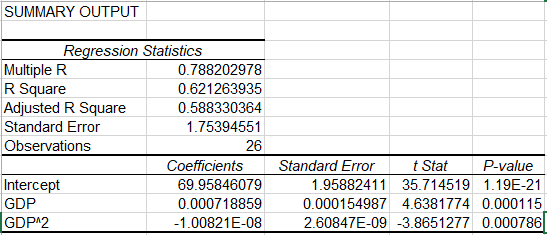
And show that both variables are statistically significant (high t Stat values), and that quite alot of the variation (around 60%) in LE can be explained by GDP/capita alone (high ‘Adjusted R Square’).
The coefficients in the last three rows imply:
(a) that in the absence of any GDP, life expectancy would be at 70 (intercept). Although this seems unreasonably high, suggesting more non-linearity in the relationship as income falls to the zero-threshold, it is not a big deal, however, as we are only concerned with the relationship over the relevant space, i.e. in terms of the GDP/capita of developed, Western countries.
(b) there is a positive relationship between GDP and Life Expectancy; namely that a one Euro increase in GDP/capita results in an increase in life expectancy of 0.0007 years. This is what we would expect to see.
(c) there is a negative relationship between GDP squared and Life Expectancy; namely that as the square of GDP rises by one euro, LE falls by 0.000000001 years. This is also what we would expect – the gains to life expectancy are limited, and at very high income levels, there may even be a reverse effect, due to stress from work, pollution or other lifestyle effects.
The graph below shows the scatterplot of actual values and the estimated line of the curve from the regression:
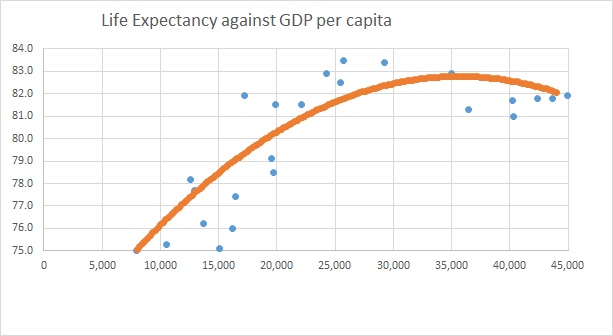
Using this model, we can estimate what the 5% reduction in GDP caused by a four month lockdown would mean in terms of life expectancy for the EU-28 countries. Here is what we get when we do that:
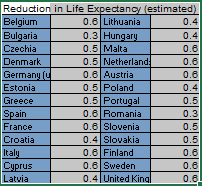
In summary, on average, a 5% reduction in GDP will result in a loss of an estimated 0.5 years, or 6 months, in the average life expectancy of people in Europe. This will happen because of many reasons, such as reduced spending on curative health, increased crime, more suicides, greater occupational risks and reduced spending in preventative health and safety.
Costs and Benefits of Lockdown (1): The Costs of Lockdown in GDP
Whether lockdowns make sense or not is an important question, and it is hard to answer definitively. Hard, for a number of reasons. First, as is often said, we do not have all the data at our disposal. On the epidemiological side, we are only just beginning to understand how the virus has been spreading and whether or to what extent lockdowns make a difference.
Quantifying the economic costs of lockdown
On the economic side, there is a large degree of uncertainty. While clearly the economic costs are large, there are inherent difficulties in untangling the costs of lockdown per se from the costs of the general COVID hysteria which would ensue, even in the absence of any government measures. And even then, calculating the costs of lockdown itself is tough. As economists are at pains to stress, this episode is without precedent in modern times, and given the extent to which Western economies have developed over the past fifty years, the older precedents such as WWII or the Great Depression, lose relevance due to the differences in how modern economies operate and the level of prosperity we have come to take as a baseline.
So we have to really try to go back to first principles. What have lockdowns done? As I see it, they have done two things to the economy. First, they have stopped production. Quite simply, governments have closed stores, factories, restaurants, bars, schools, etc., meaning there are fewer goods and services being produced by the economy. How much of the economy is now closed depends on the nature of the lockdown (France, Italy, Spain, Belgium, Germany, New York City, Michigan, Ireland…, are extreme examples; many other US states and the Netherlands less extreme, Sweden the least extreme), but easy estimates put the number at close to a third of the economy.
In some cases, production will have shifted from the formal to the informal economy: restaurants are no longer preparing food, but people are cooking more at home; teachers are no longer caring for and minding children, but parents are doing so at home, etc. However, in many cases, the production is simply being lost. Again, how much is the result of the lockdown and how much of the generalised COVID panic which would have occured anyway? It’s difficult to say, but to put the loss at 15% of the economy does not seem unreasonable, especially when we consider that the two are interlinked: people panic in part because governments lockdown.
The second effect is the productive efficiency loss. We can take teleworking to be less efficient that working in offices, as otherwise the economy would have phased to telework years ago. (After all, the technology is not particularly new and companies wouldn’t willingly fork out for prime office space if they could get the job done as efficiently with no rental costs.) Home schooling is also a large efficiency loss, related to scale diseconomies (a class of 24 formally taught by one teacher, is now being taught by 24 parents) and the fact that parents are not trained teachers. Supply chain disruptions mean that work stoppages occur even in otherwise unaffected sectors: E.g. construction companies cannot pop down to the local supply shop to get an extra bucket of 3″ screws). Quantifying these efficiency losses is tricky, especially because they may be partially offset by some efficiency gains (fewer useless meetings for people to sit through).
There is also, I think, a non-linearity here with regard to time. If we think of businesses as having both an operational and a strategic component, then the former can probably cope better with remote working for some time, and in the short term, a company can get by without a new strategy. But in the long term, the lack of face-to-face contact will make strategic decisions like restructuring, brainstorming, hiring and firing…, much more difficult. This means fewer new ideas, less innovation, less efficiency gain.
Finally, there is the economic impact of social costs. The harm to people’s mental health from isolation, the loss of emotional development for, in particular, vulnerable children. The scarring effects of unemployment and disattachment from the labour market for those who have lost their jobs. While these are all first and foremost social costs, they will also impact the economy through reduced output, higher crime and wasted human potential. Again, these are non-linear with regard to time: the longer the lockdowns go on, the more costly each added day of lockdown will be.
Quantifying all these effects is not easy. If we take as a baseline four months of effective stoppage, and assume this halts 15% of output, then countries in full lockdown can expect at least a 5% one-off loss to annual GDP from the first effect. For the other two, the effects are likely to be more drawn out, but less acute. Using the four-month baseline again, the efficiency cost of teleworking could be estimated using the rental value of the office space currently being leased. In the EU, there is an estimated 650 million square meters. At an annual rent of €400 per square metre per year, this makes about 90 billion in lost office for the 4 month period, or about 0.5% of GDP. Of course, this is a lower bound; it’s reasonable to assume, given the transition costs associated with the shift, that this number is closer to a full percentage point in GDP.
Next is lost productivity for parents. Here we can assume that working parents of dependent children suffer, as a result of the caring responsibilities. Data is available from Eurostat on employment rates of parents by number of children, the distribution of population by number of children. Combined with data on industrial annual earnings for the age group 30-39 (a proxy), we can estimate the lost productivity using wage data and assuming single parent households lose 50% of productivity, two parent households with one or two children lose 25% of productivity and households with three children lose 10% of productivity. (Households with more than two adults are assumed not to lose productivity). This amounts to another €90 billion for the 4 month period, another 0.5% of GDP.
Other costs arise from the stoppage of routine medical activity and the mental health toll. Here indeed, disentangling lockdown from baseline costs is tricky. Undoubtably, any alternative to lockdown would carry with it a certain mental toll, as well as an increased (albeit likely short term) demand on health services. Similarly, other social costs such as the damage to disadvantaged children cannot be readily quantified, but are nevertheless important qualitative considerations.
In summary, the upfront costs of a four month lockdown can be roughly estimated to be between 15 to 20% of GDP, with scarring effects causing a permenant reduction of GDP that is far more difficult to quantify – not least because it will depend on the policy response. Given these impacts on human capital, on educational outcomes for children and on mental and physical health, it seems difficult to imagine a swift V-shaped recovery. In present value terms, a permenant drop in the order of 5% does not seem like an unreasonable working assumption.
Lockdown madness goes on, even as science shows COVID isn’t that deadly

Cher Daniel, ma dixième lettre a toi
Mon cher fils,
Tout d’abord un grand bonjour a toi de ma part. Ca fait un bout de temps que je ne t’ai plus ecris, c’est vrai. Malrge, j’ai beaucoup pense a toi ce dernier temps, et surtout avec l’arrivee du coronavirus. Tout est devenu si etrange, avec les rues presque vide. Et en quelques sortes, ca fais que je pense a toi encore plus que normal.
Par exemple, je sais que ton ecole est maintenant fermee! Est-ce que tu arrives a bien travailler depuis chez toi? Et malgre l’interdiction de sortir (sauf pour prendre l’air) est-ce que tu arrives a t’amuser un peu? C’est surtout difficile comme il n’y a plus des cours, des activites organisees, rien quoi. Et tu ne peux meme pas rencontrer tes copains pour jouer ensemble.
Nous ici, ca va. Au moins l’appartment est suffisament grand. Ta petite soeur ne va plus a la creche, comme les places sont reservees aux enfants dont les parents doivent travailler sur place (moi je peux maintenant travailler depuis chez moi). Mais ce que je trouve le plus difficile c’est le fait qu’on ne sais pas pour combien de temps cela va durer. Apres Pacques? Tout le monde dit que c’est presque sur que ca ira encore au dela du 5 avril.
Mais bon, au moins tout le monde a de quoi a manger, nous avons la tele, les livres et nos proches. Moi je suis beaucoup sur Skype et je parle a ton grand-pere et ton oncle Jude aux Etats-unis et ta grande soeur en Irlande. Ils vont tout les trois tres bien, d’ailleurs. Et si on arrive a sauver les vies, ca vaut la peine avec les mesures un peu dur, non?
Autre chose qui donne espoir, c’est le beau temps qu’il fait depuis une semaine. Vraiment, ca aide a oublier les contraints, quand on voit de jour en jour comme le printemps arrive et nous gate!
Ok, je vais m’arreter la. Je prie pour toi et toute ta famille. Rien que de la paix et de la joie, mon petit Danko-Panko.
Bisous virtuelles,
Dad
My review of ‘I Am Pilgrim’ by Terry Hayes
 I Am Pilgrim by Terry Hayes
I Am Pilgrim by Terry Hayes
My rating: 2 of 5 stars
It takes special skill to write a book with over 850 pages – all of which are torturously overwritten and peppered with cheap hyperbole – and yet still retain the attention of people accustomed to better. Terry Hayes possesses this rare talent.
I am a slow reader, with diminishing patience for crappy writing as I get older and crankier. In the months it took me to get through ‘I Am Pilgrim’, there were moments when I literally winced at the bad writing. There were times I thought, that’s it, I’m done with this cliche-ridden piece of trash.
Yet I kept coming back for more. Partly this was an act of loyalty to the man who wrote the screenplay for one of the great, childhood-defining movies of the 1980s: ‘Mad Max: Beyond Thunderdome’. But it was also because I Am Pilgrim has something seriously good to offer.
What Hayes lacks in classical writing talent, he as good as makes up for through the books two principle strengths: first, his attention to detail and second, the muscle behind his storytelling. For the first, the secret agent protagonist (whose name I have, tellingly, already forgotten) is given a severe credibility handicap by Hayes’ inability to imbue him with any real depth of character. And yet the detailed descriptions of how he approaches his work, the tricks of his trade, make you share in his world. Some are deliciously simple, such as when he points out that the way to break into someone’s house is not to creep around the dark with a flashlight (which neighbours tend to notice), but simply to switch the light on and move through the house normally.
But it is the second strength, the storytelling, that is the real reason I kept swerving around every unnecessarily unnecessary adverb and past every pastiche minor character. Hayes wrote ‘I Am Pilgrim’ not because he wanted to write a book and needed a story to fill it. He wrote it because he had a story to tell and a book was a way of getting that story out into the world.
The plot is perfectly paced. It builds suspense as it needs to and juggles competing story lines via a narrative voice with multiple layers stretched just to the limits of credibility. There are not many writers who will dare to depart on a chapters-long diversion to narrate the backstory of a villain whose crime has not even been hinted at. But Hayes gets away with it, precisely because the reader is left in the certain knowledge that the storyteller knows exactly where all this is going.
I won’t say too much about the conclusion, for two reasons. First, I hate spoilers. But second, if you’ve managed to forgive Terry Hayes all the sins against literature he committed in the preceding 849 pages, what happens from page 850 can no longer harm you.
So if you want a good read, look elsewhere. But if you want a good story, this is a Pilgrimage worth embarking on.
Joyeuses fetes, mon cher fils! (Ma 9ieme lettre)
Cher Daniel,
Ça fait un bout de temps que je n’ai plus écrit, c’est vrai. Malgré, j’ai pensé beaucoup à toi ce dernier temps. Des souvenirs me sont revenus, de l’hiver 2010/2011, juste avant ta naissance. Moi et ta maman ont été très excité de te voir. Il neigeait beaucoup cet hiver-là. Avec une voiture empruntée des amis, j’ai même conduit ta mère à l’hôpital la veille de Noël, dans la neige, parce qu’elle pensait que tu allais arriver un peu tôt. Mais non, tu n’avais pas encore envie à ce moment-là! La voiture, hélàs, a été entretemps remorquée parce que, dans la panique, je n’ai pas fait attention à l’affiche qui interdisait de garer la voiture devant l’hôpital! Tu es resté au chaud encore jusqu’en janvier (comme tu le sais). Et donc ton premier Noël n’était qu’en 2011…
…maitenant on va fêter Noël 2019 avec tes deux soeurs, Anna et Daphné. Ton oncle sera aussi là. Nous avons chez nous un très beau sapin avec beaucoup de place autour pour les cadeaux apportés (j’espere!) par le Père Noël.
Et toi? J’espère que tu as été sage, et que des cadeaux t’attendent aussi (et qqchose de bon à manger!). J’ai malheuresement pas le droit de te donner un cadeau, mais saches que dans mon coeur, je t’embrasse tres fort, mon cher fils.
Joyeux Noël,
-Dad (ton père)
The ‘political centre’ isn’t collapsing so much as reforming
Turning and turning in a widening gyre
A conventional narrative among political commentators of our day has been one of increasing polarisation and a collapsing ‘middle’. In economics, leading international think-tanks like the OECD are writing reports with catchy titles like “Under Pressure: The Squeezed Middle Class“. In the media, pundits are falling over each other to predict the demise of the political centre.
And while the centre may indeed be under threat, there is little-to-no evidence of increased political polarisation. Across Europe, an unprecedented number of ‘grand coalitions’ have arisen in recent years, bringing traditionally opposed centre-right and centre-left parties into government together. While very recently there has been some weakening, the bigger picture is how remarkably stable this arrangement has proven. Meanwhile across the Pond, despite what social media outrage would have you believe, the extent of bipartisanship has been on a steady rise for almost a decade – spanning both Obama II and the Trump Administration. This should come as no surprise to anyone paying attention to how the American political system really works. The donor class tends to stick its fingers into both the Republican and the Democrat pies, in more or less equal measure. Party bickering is a useful tool to deflect public attention away from the real issues, but when it starts to impede on the business of the State, the interests are quick to take notice.
The worst lack all conviction
Yet there is a divide opening up, of another kind. I see it as the increasing disparity between the interests of the political class and those of the people they are supposed to serve . In this sense the ‘middle’ is, and has always been, a careful compromise between the public interest and the interests of those who represent the public. The fact that vested interests and lobbyists choose to buy favour among the political class is nothing new. It is how business gets done. What has changed is the extent to which those vested interests deviate from the public interest. As globalisation and increasing human population ratchet up the scale and reach of public policymaking, the stakes go up. The decisions of our day – on how to regulate corporations that are bigger than countries, on how to handle the migration of millions, on how to deal with climate change – are bigger than anything we have faced before. This means public policy matters more, and the size of the ‘middle’, the gap between the people and its representatives, is growing.
In America, the Democrats have traditionally positioned themselves closer to this space, but at least since the Obama Administration it has become piercingly clear to anyone watching that establishment Democrats have moved far, far away from the interests of ordinary people. The two-party system prevents them from experiencing an out-in-out decline, simply because there are no voting alternatives. Yet the fracturing witnessed among the base during the 2016 Presidential campaign had the same political effect. Since 2004, the percentage of Americans identifying as politically independent has been on a steady rise, and now outnumbers either Democrats or Republicans.

In Europe, the near universal decline of ‘centre’-left social democrat parties – once the parties of the masses – tells a similar tale of elites leaving their bases behind. The ‘centre’-right too has drifted away from its base; in Germany most notably through the policies of open immigration which the CDU Chancellor Merkel pursued in the teeth of public opposition.
Other issues foster latent resentment, such as the ever-expanding grasp of monopolies under the guise of intellectual property rights. Voters might not know exactly how political elites have allowed corporatists to privatise public ideas, but they can sense it. It feeds into a wider sense of social malaise.
But where the Establishment has abandoned the middle most evidently is in American military foreign policy. The consensus among ordinary Americans against funding rogue regimes like Saudi Arabia and getting stuck in endless, pointless regime-change wars like Afghanistan and Syria is as overwhelming as it is obvious. What is not as obvious is how political representatives fail to take any action: A bipartisan bill sponsored by Rand Paul to curb Presidential power in this respect and withdraw from Afghanistan has languished in the Senate since April. Why? Surely it is because the political elites are captured by a vested interest, this time the military industrial complex.
While the best are full of passionate intensity
In the face of this drift, the ‘collapse of the middle’ is the death of the convenant these traditional Establishment parties had with the public they only ever uneasily served. But others are moving quickly to fill the space, and the Establishment is quick to brand them with the now-tired dysphemism ‘populist’. Trump is commonly thought of as being in the vanguard of this new kind of populist. But in truth, he is only the loudest and most showmanlike of its outriders. In Eastern Europe, where the Establishment was less … established, populist leaders responded to the drift more quickly.
And on the political left, the wrangling over the 2020 Democratic party nomination shows this new divide quite clearly. On one side, the Establishment candidates, led by Joe Biden, Pete Buttigieg, Cory Booker, and … it would seem, Elizabeth Warren. They are backed by big donors but get only a lukewarm reception from the public. Against them the three anti-establishment candidates – the ‘populists’ if you will – of Bernie Sanders (with his vastly popular Medicare for All plan), Tulsi Gabbard (with her vastly popular End Regime-Change War platform) and Andrew Yang (with his vastly popular Universal Basic Income plan). They fight an almost endless battle against media smears and unfavourable coverage, relying on the internet for publicity and on small political donations from actual grassroots supporters for cold, hard cash. Since in this light, it’s wholly unsurprising that they are the candidates Trump voters are most likely to support if they decide to switch. After all, they are fellow ‘centrists’.
One does not have to look very long at history to guess which side will eventually come out on top. The Establishment, as it veers towards the extremes, will crack and fade and a new political middle will reform. It’s already happening. The pundits on television just don’t know it yet.

